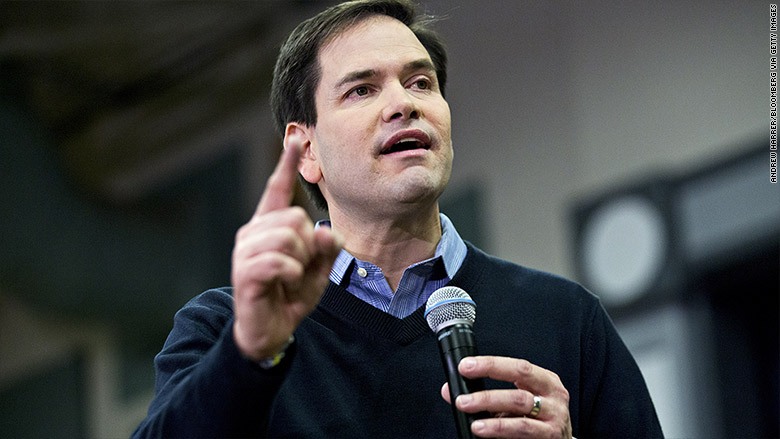
Marco Rubio would give tax cuts to everyone.
But the biggest would go to the wealthiest taxpayers and add at least $6.8 trillion to the debt over a decade -- or $8.2 trillion if interest costs are included. Deficits in the second decade would be even larger.
That's according to a new analysis from the Tax Policy Center released Thursday.
"If the numbers added up, it would be a radical and innovative plan," said Len Burman, the Center's director.
That's largely because Rubio would replace today's income tax with a so-called progressive consumption tax. Essentially that means he would still tax wage income at various rates but eliminate all taxes on individuals' savings and investment income. For businesses, he would let them immediately write off all investments but eliminate their interest deductions.
Here are just a few highlights from the plan:
Impose fewer and lower income tax rates
Rubio's plan would reduce today's seven income tax rates to just three: 15%, 25% and 35%, which is below today's top rate of 39.6%.
Meanwhile, corporations and other businesses, such as partnerships, would only pay a 25% top rate, well below their top tax rate today.
The fact that business income would be taxed at a much lower rate than wage income could tempt a lot of people to recharactertize their ordinary income as business income, Burman noted.
Related: Jeb Bush would cut everyone's taxes but ...
No longer tax corporations' foreign-earned income
Today U.S.-based multinationals must pay U.S. tax on all their income regardless of where it's earned, although they get a credit for all taxes paid to foreign governments and don't owe the tax until they bring the money home.
Rubio would replace this so-called worldwide tax with a territorial tax system, meaning multinationals would only owe tax to Uncle Sam on the profits they make on U.S. soil.
But he'd impose a one-time 6% transition tax that corporations would have to pay on their existing tax-deferred foreign earnings.
Kill off several taxes and breaks
Rubio would eliminate a number of taxes. They include the Alternative Minimum Tax, the estate tax, and all taxes created under Obamacare.
He also would eliminate all itemized deductions. But he would preserve the deductions for mortgage interest and charitable contributions, and make them available to everybody whereas currently they're only available to itemizers.
And, lastly, he would eliminate all taxes on capital gains, dividends and interest savings.
Related: Donald Trump's big tax cuts come at a big cost
Replace old breaks with new, more consolidated ones
Under the GOP candidate's plan, a number of higher education tax breaks would be combined into one $2,500 tax credit for anyone with income up to 500% of the poverty level.
He'd replace the standard deduction, the personal tax exemption for filers and the 10% tax bracket with a $2,000 personal tax credit ($4,000 for joint filers). The credit would be partially refundable, meaning a filer who ends up with no income tax liability could still receive some payment for the credit.
He'd also create a partially refundable child tax credit worth up to $2,500 per child and available to households with incomes up to $400,000. It would be in addition to the child tax credit in today's code.
So how big of a tax cut would you get?
The Tax Policy Center estimates that Rubio's plan would cut filers' taxes by an average of $3,150 in the first year, boosting their after-tax income by 4.4%.
But the biggest cuts by far -- both in dollar and percent terms -- would flow to the top 0.1% of filers, whose household income tops $3.7 million a year. They would see an average tax cut of more than $900,000, boosting their after-tax income by nearly 14%.
Middle income households, by contrast, would see their tax bills drop by an average of $1,400, or 2.5% of their after-tax income.
The numbers shrink further for the poorest households. Their tax cuts would average $250, or 1.9% of income.
How Rubio's plan could affect the debt and economy
The Center noted that the Rubio campaign did not respond directly to its questions, so its analysts had to make assumptions about some measures in the plan. Where they did, they chose those that would cause the least amount of revenue loss.
Even so, the deficits that would accrue could offset the positive economic effects of the plan, which include boosting incentives to work, save and invest.
The analysis also noted that the deficit effects could be smaller if Rubio made severe spending cuts. But the magnitude required would be unprecedented. And even if they were made, "[it] could reduce economic growth if the spending cuts reduce public investments that boost growth."
Rubio pushed back against the Center's conclusions during a media gaggle in South Carolina. He asserted that the analysis doesn't account for the economic growth his plan would generate, which in turn would result in more revenue.
"In terms of the debt part of the equation, we have to deal with spending for that, and that's what my reform programs will do for Medicare and Social Security," he said, noting that his reforms wouldn't affect current beneficiaries.
